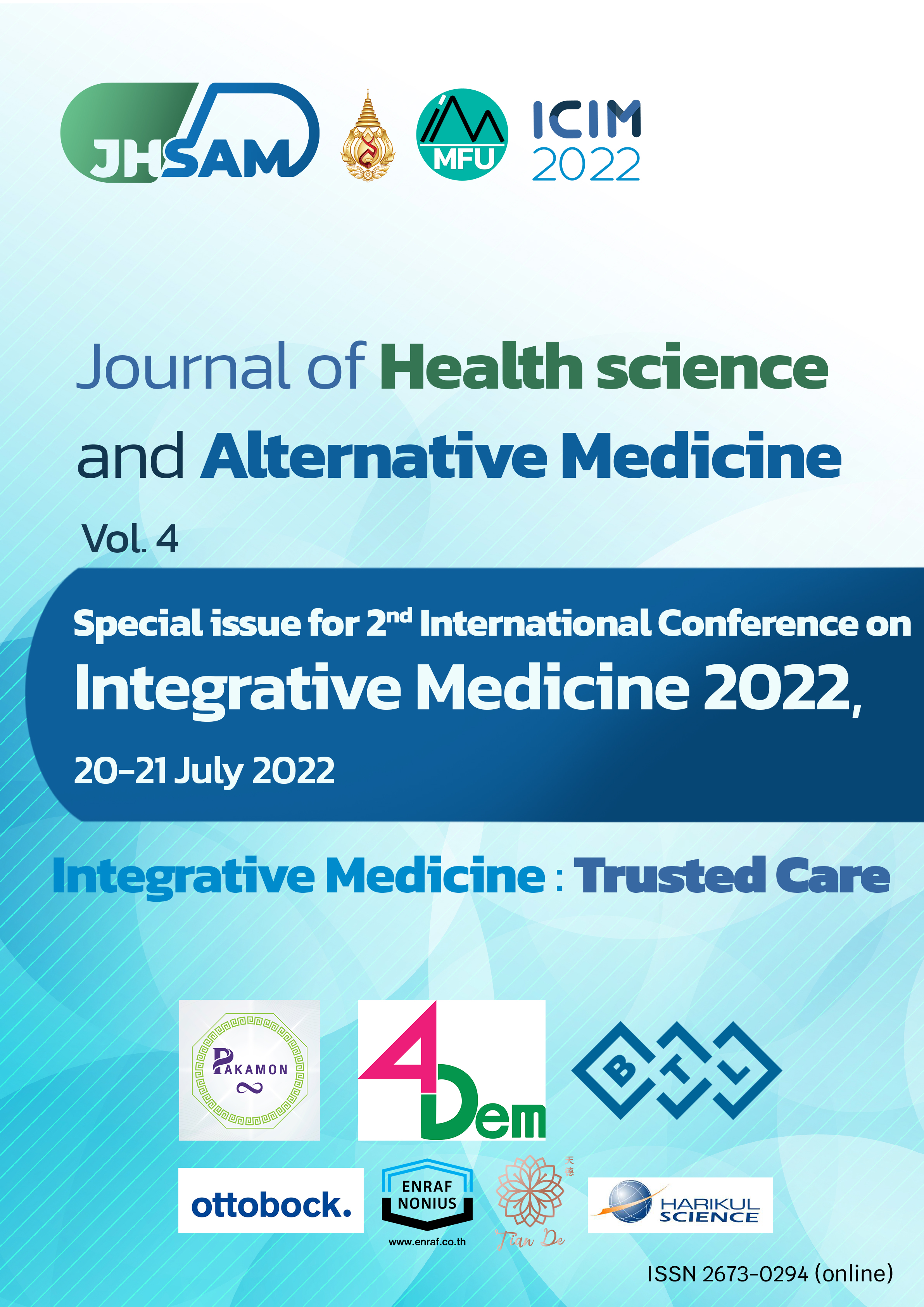C12. Research on Operation Method of Tuina Treatment of Constipation in Children Based on Data Mining Technology
Main Article Content
Abstract
Objective: To explore the Tuina manipulation (manipulation and acupoints) for treating pediatric constipation.
Methods: Randomized controlled clinical studies (RCTs) on treating pediatric constipation by Traditional Chinese Medicine (TCM) Tuina were searched from the self-established database of PubMed, Web of Science, Cochrane Library, CNQI, VIP, and Wanfang database to December 2020. SATI, UCINET, and other data mining software were used to analyze the frequency statistics, visualization centrality and support degree of relevant operation methods (manipulation + acupoint) of TCM Tuina treatment for pediatric constipation, and SPSS 26.0 were used for cluster analysis.
Results: A total of 874 pieces of literature were retrieved, and 133 RCTs literature were included after screening. Data shows 101 undifferentiated constipation prescriptions and 94 differentiated constipation prescriptions (including 48 excessive constipation and 46 deficient constipation). The results show undifferentiated constipation with abdominal rubbing manipulation (frequency 70, support 69.3%), pushing down Qijiegu manipulation (frequency 69, support 68.3%), clearing the Large Intestine manipulation (frequency 69, support 68.3%) has the highest centrality, which is a commonly used in combination. For excessive constipation, Clearing the Large Intestine manipulation (frequency 40, support 83.3%), pushing down Qijiegu manipulation (frequency 40, support 83.3%), abdominal rubbing manipulation (frequency 38, support 79.2%), Tuiliufu manipulation (frequency 35, support 72.9%) and the centrality is the highest, which is a commonly used in combination. For deficient constipation, strengthening spleen meridian (frequency 40, support 87.0%), spine pinching manipulation (frequency 37, support 80.4%), pushing Sanguan manipulation (frequency 32, support 69.6%) with the highest centrality, which is a commonly used in combination.
Conclusion: The main idea of pediatric Tuina treatment of constipation is the dredging method. They are usually treated by rubbing the abdomen, pushing down Qijiegu, and clearing the Large Intestine manipulation. Tuisanguan and clear away heat and toxic material manipulations are frequently used to treat excessive constipation. For deficient constipation, strengthening spleen meridian, spine pinching, and Tuisanguan manipulations are frequently used to replenish Qi, strengthen the spleen and relieve constipation.
Article Details

This work is licensed under a Creative Commons Attribution-NonCommercial-NoDerivatives 4.0 International License.
JHSAM publishes all articles in full open access, meaning unlimited use and reuse of articles with appropriate credit to the authors.
All our articles are published under a Creative Commons "CC-BY-NC-ND 4.0". License which permits use, distribution and reproduction in any medium,
provided that the original work is properly cited and is used for noncommercial purposes.
References
中华医学会,中华医学会杂志社,中华医学会消化病学分会,中华医学会全科医学分会,中华医学会《中华全科医师杂志》编辑委员会,消化系统疾病基层诊疗指南编写专家组.慢性便秘基层诊疗指南(实践版·2019)[J].中华全科医师杂志,2020,19(12):1108-1114.
Koppen IJN, Vriesman MH, Saps M, et al. Prevalence of Functional Defecation Disorders in Children: A Systematic Review and Meta-Analysis[J]. J Pediatr. 2018,198:121-130.e6.
杨春松,张伶俐,任燕,等. 国内儿童功能性便秘患病率和纤维素治疗有效性的文献评价[J].中国药事,2017,31(05):579-583.
杨从云,高楠峻. 儿童及青少年功能性便秘流行病学调查及危险因素分析[J]. 临床医药文献电子杂志,2020,7(34):180-181.
Gallegos-Orozco JF, Foxx-Orenstein AE, Sterler SM, et al. Chronic constipation in the elderly[J]. Am J Gastroenterol. 2012,107(1):18-26.
Ho JMD, How CH. Chronic constipation in infants and children[J]. Singapore Med J. 2020,61(2):63-68.
郭敏,常克. 小儿功能性便秘的临床治疗[J]. 现代中医药,2017,37(01):21-22.
张勇,李胜,王锋,等. 推拿治疗儿童功能性便秘的系统评价[J]. 针灸临床杂志,2017,33(06):42-45.
曹方,宋柏林. 推拿治疗小儿便秘选穴规律[J]. 中华中医药杂志,2018,33(06):2364-2368.
清·张振鋆 厘正按摩要术[M].北京:人民卫生出版社,2007.
刘明军,王金贵. 小儿推拿学[M].北京:中国中医药出版社.2016.
高旭杰. 摩腹在小儿先天性心脏病直视术后胃肠能恢复的临床研究[D].广州中医药大学,2010.
胡安娜,高沛友,吴凡,等. 小儿推拿治疗儿童功能性便秘的临床研究进展[J].按摩与康复医学,2019,10(03):57-60.
刘南飞,郭思佳,封继宏. 推拿治疗儿童功能性便秘的研究进展[J].医学综述,2017,23(19):3907-3911.
相祎,刘力,杜晓泉,等. 便秘中医诊治探微[J]. 现代中医药,2021,41(04):73-76.
何玉华,康静. 手法推拿治疗小儿开塞露依赖性便秘[J].中国针灸,2011,31(03):258-259.
赵娜,范青,王金贵. 小儿捏脊手法操作与“药性”探讨[J].天津中医药,2018,35(03):186-187.
李学超,刘昱材,李梦莹,等. 捏脊疗法对胃运动过缓家兔胃饥饿素及血管活性肠肽含量的影响[J].中华中医药杂志,2016,31(02):637-639.
王丽清,葛金玲. 捏脊疗法治疗小儿外感发热的免疫及肠道微生态机制研究[J].河南中医,2007(10):25-27.
梁众擎,董盈妹,赵霞. 从五脏一体观论治小儿功能性便秘[J]. 中医杂志,2018,59(12):1066-1068.
施敏,刘富林,夏旭婷,等. 中药治疗慢传输型便秘临床疗效的Meta分析[J]. 湖南中医杂志,2021,37(07):126-130.
王梦雪,任勤. 任勤辨治小儿便秘经验采撷[J]. 中国民间疗法,2021,29(13):49-51.

